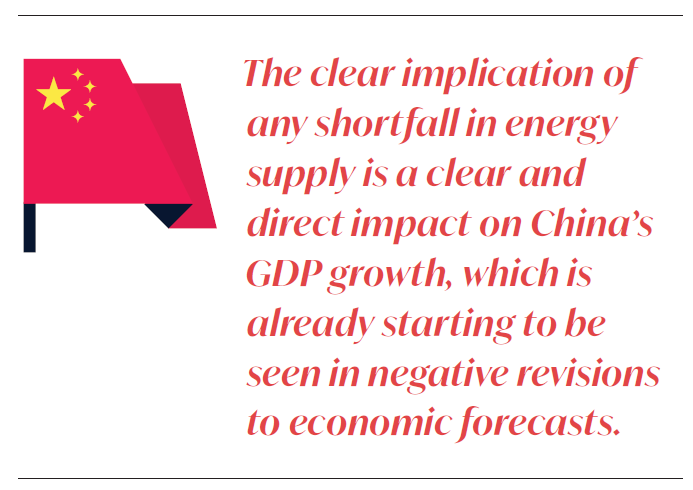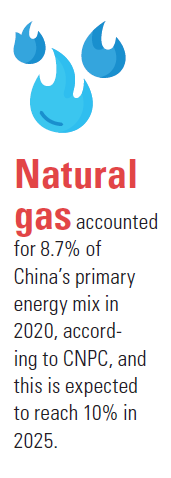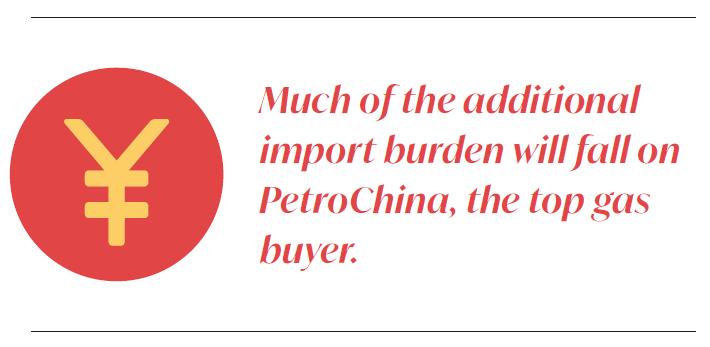China endures worst energy crisis in decade [Gas in Transition]
China’s worst energy supply crunch in a decade is likely to ease this month as its policymakers take steps to bring in more resources, but Beijing’s response to the crisis could set off a scramble for global energy commodities that could leave some countries out in the cold this winter.
Since the late summer, local bureaucrats in two-thirds of China’s provinces have enforced power-saving measures on companies in energy-intensive sectors ranging from chemicals and steel to non-ferrous metals and mining. The measures range from restricting additional production capacity and limiting power usage to raising electricity prices, rationing power and even ordering some factories to halt production.
At its height in late September, the supply crunch stretched from the northeastern provinces of Jilin, Heilongjiang and Liaoning to the manufacturing powerhouses of Jiangsu, Zhejiang and Guangdong on China’s eastern and southern seaboards.
The sudden and widespread impact of the power shortages jolted the central government into action at the end of September. The National Development and Reform Commission (NDRC), China’s powerful economic planning agency, took administrative measures that included ramping up domestic coal output, boosting both coal and LNG imports and adjusting currently inflexible electricity tariffs for coal-fired power generators.
The barrage of measures came as the depth of concern in China’s top leadership over the crisis became apparent. Every effort will be made to maintain economic growth and the needs of basic livelihoods will be met while industrial and supply chains will be kept stable, premier Li Keqiang was quoted as saying by Chinese official media.
The government’s short-term actions indicate that the energy crunch will soften in October but the outlook remains unclear. The looming onset of winter means the risk of further energy shortfalls could persist until spring next year and become more severe under extreme weather conditions. This means China’s imports of coal and gas will remain at elevated levels, intensifying competition for supplies with countries in Asia and Europe.
Roaring demand
While China is no stranger to energy shortfalls – power blackouts also occurred last winter while there were severe gas shortages in the winter of 2017-2018 – the sense is that this year’s deficit is different as it coincides with Europe’s worrying supply tightness and is taking place weeks before the winter, when energy consumption usually peaks to meet residential demand for heating.
The crunch in China comes amid a surge in domestic primary energy consumption this year as robust post-Covid demand from manufacturers and industry has outpaced improvements in energy conservation. Coal consumption in the first six months climbed by 10.7% year-on-year and was up by 8.1% from the first half of 2019, while gas usage over the same period increased by 21.2% from 2020 and 23.5% from 2019.
 Energy and GDP growth in China remain inextricably linked despite efforts to reduce the energy intensity – energy use/unit of GDP – of the Chinese economy. The strong recovery in China’s economic growth since its brief bout of Covid restrictions in early 2020 has resulted in similarly strong demand for energy. China’s primary energy consumption is poised to grow by 4.8% this year, which would be the strongest gain since 2011, according to Bernstein Research.
Energy and GDP growth in China remain inextricably linked despite efforts to reduce the energy intensity – energy use/unit of GDP – of the Chinese economy. The strong recovery in China’s economic growth since its brief bout of Covid restrictions in early 2020 has resulted in similarly strong demand for energy. China’s primary energy consumption is poised to grow by 4.8% this year, which would be the strongest gain since 2011, according to Bernstein Research.
The clear implication of any shortfall in energy supply is a clear and direct impact on China’s GDP growth, which is already starting to be seen in negative revisions to economic forecasts. Since September, Fitch Ratings, Bank of America, Goldman Sachs and Nomura have all cut their projections for Chinese growth for 2021 and 2022 due to the energy squeeze.
King coal the culprit
The initial speculation for the power outages and cutoffs was that Beijing’s efforts to curb total energy consumption and energy intensity – the so-called “dual control” policy – were to blame. Twenty out of 30 provinces, regions and municipalities failed to meet either energy consumption or energy intensity targets for the first half of 2021, prompting the NDRC to announce last month tougher punishments for regions that fail to achieve the goals.
But the view now is that high coal costs and shortages of China’s dominant energy source are the primary culprits. Soaring coal prices led to much of China’s available power generation capacity going offline, causing power supply shortages. Coal accounted for 57% of China’s primary energy mix last year as well as 60% of installed power generation capacity.
Since the beginning of this year Chinese coal prices have doubled or almost tripled in some regions, reaching more than $200/mt in September. The price spike has been mainly due to coal demand growth outpacing coal supply. Tight global coal markets and rising global gas prices have also driven up Chinese coal prices.
At the same time China’s coal-fired power fleet has been unable to pass on the higher fuel costs to end-users as power tariffs are largely regulated by the NDRC. Rather than generate power at a loss – for which they would be penalised by Beijing in year-end performance reviews – some coal power stations have preferred to undergo maintenance to reduce their losses or avoid replenishing coal stockpiles amid limited supply. This slashed operating capacity, which then led to tight power supply in many provinces.
Turning up the gas
Beijing is turning to increased gas use to help alleviate the coal shortages, but it faces challenges here. China’s gas demand grew by 17.1% in the first seven months of 2021, a strong increase that was driven by colder temperatures last winter and then a recovery in industrial and commercial gas demand. The National Energy Administration has forecast this year’s demand to reach 365-370bn m³, which would represent growth of around 13%.
The NDRC has said that 174.4bn m³ of gas supply is guaranteed for this winter, but nevertheless has directed state-owned energy companies to secure additional supplies. With the benchmark Japan-Korea Marker recently touching a historic high of $56/mn Btu earlier this month, large state-backed importers will need to dig deep into their pockets to outbid buyers from other parts of the world that are also hunting for cargoes.
China’s gas imports during January-August climbed by 22.2% to 79.31mn mt, equivalent to 109.4bn m³ and making up 44.5% of national gas supply. Greater Chinese procurement could exacerbate the global deficit in gas inventories in Europe and Asia in the run-up to the winter peak demand season – and the emerging competition for gas and LNG suggests supply tightness is unlikely to ease any time soon.
Winter squeeze to pressure PetroChina
Much of the additional import burden will fall on PetroChina, the top gas buyer. This is likely to put pressure on the state-owned company’s earnings, as it will need to import more fuel at a loss to meet Beijing’s demand for more energy supplies.
PetroChina loses money when it sells imported gas in the domestic market because import costs are often higher than state-regulated gas prices that are set by the NDRC. The company lost 14.2bn yuan ($2.20bn) on the domestic resale of imported gas last year, which was a significant improvement from losses of 30.7bn yuan in 2019 and 24.9bn yuan in 2018.
PetroChina continued turning the situation around in the first quarter of this year as last year’s pandemic-led collapse in oil and gas prices filtered through to the NOC’s import costs. The Chinese major turned a profit of 8bn yuan on sales of imported gas in Q1, but the reprieve was short-lived as it swung to a loss of 5bn yuan in Q2, according to CFO Chai Shouping on an earnings call at the end of August.
The company imported 37.2bn m³ in the first six months, according to Chai, and analysts have forecast volumes to reach 85bn m³ for 2021.
The expectation is that import losses will extend into the third and fourth quarters, but to what extent remains uncertain – the deciding factor will come down to how much imported gas China needs this winter. PetroChina said in early October that it expects domestic gas demand to grow by 8.3% this winter from a year earlier.
The downside for PetroChina is the rising cost of hydrocarbons worldwide. This year’s rally in Brent to more than $80/b and the current extreme tightness in global gas markets have made spot and term LNG, and piped gas imports more expensive in the run-up to this winter compared with a year ago – which points to a greater import loss for PetroChina.
Any additional imports on top of what PetroChina has already contracted for this winter will likely originate from the Asia-Pacific spot LNG market. PetroChina’s potential loss on reselling these high-cost volumes in China would be significant given the huge gap between Asian spot prices and regulated rates.
On the other hand PetroChina has worked harder since the beginning of this year to keep a lid on import costs, as emphasised on the earnings call by Chai, who said the NOC would aim to keep a lid on losses for the rest of 2021 by producing more domestic gas to lessen the need for imports whilst also seeking lower-cost gas imports to reduce losses.



